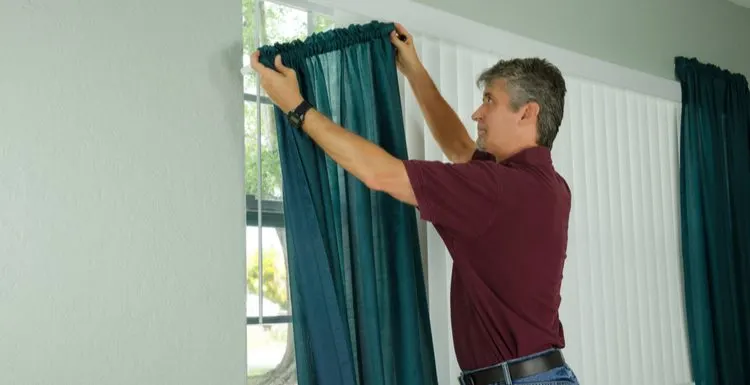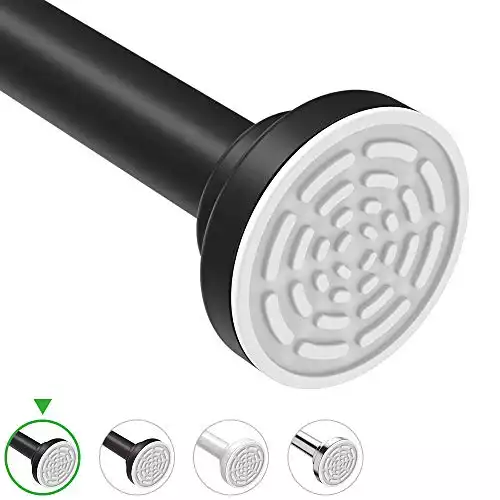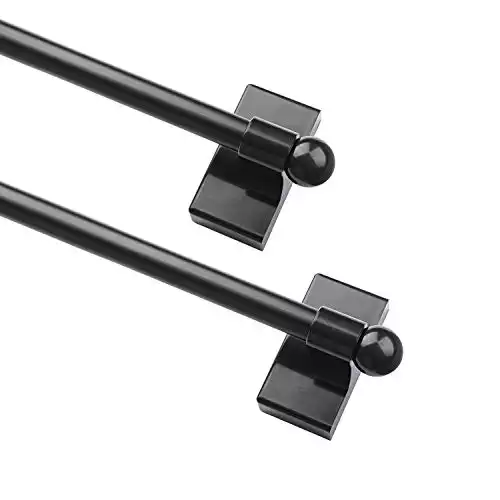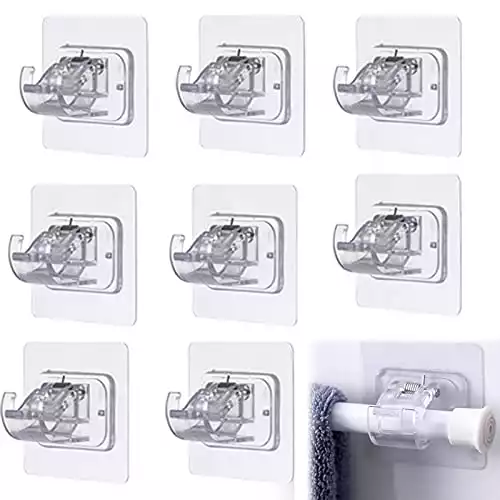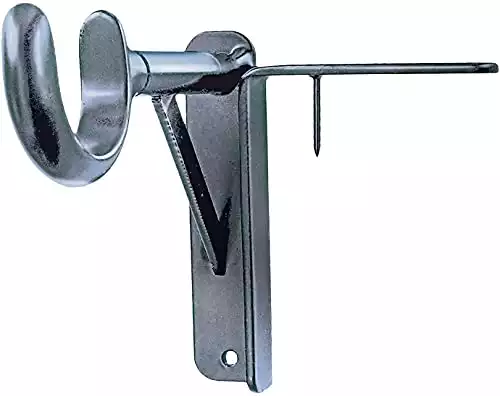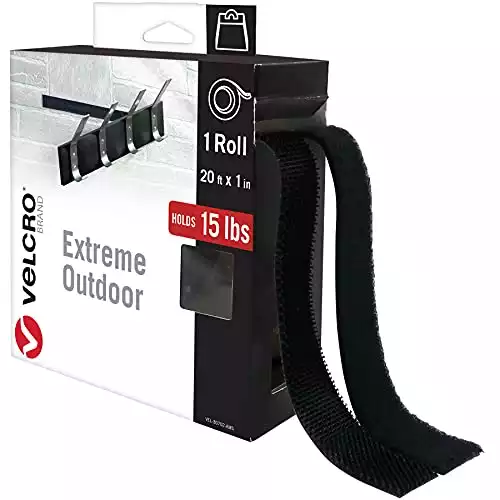Hanging curtains without nails might seem impossible, but it’s not as hard as it sounds.
Read on for all the information you need to put curtains up without nails, including a list of supplies and a step-by-step guide.
Hanging Curtains Without Nails: A Summary
The first step in hanging a curtain without nails is to select a suitable alternative from popular options like tension rods, magnetic curtain rods, command hooks, no-drill brackets, or Velcro.
Depending on your chosen method, you will have to prepare the curtain for hanging accordingly before installing it in your window or door frame.
How to Hang Curtains Without Nails in 5 Steps
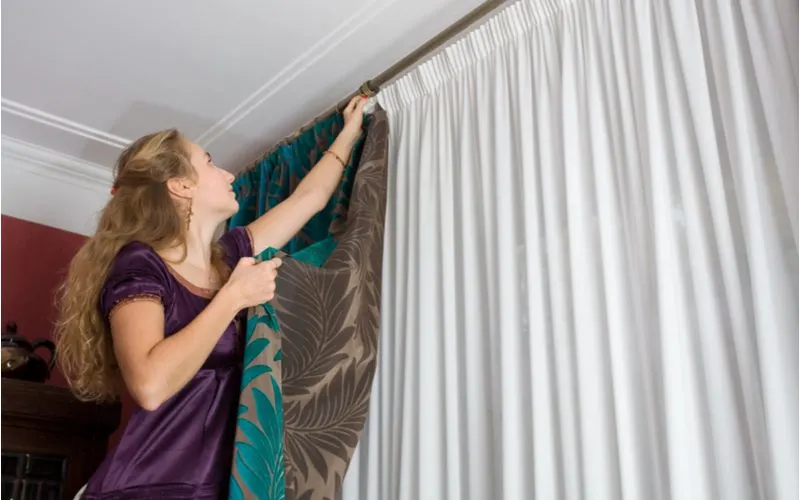
Dontsov Evgeny/Shutterstock
Step 1: Select Your Alternative Method for Hanging
You don’t need a hammer and nails to hang a curtain. However, you do need something that you can suspend the fabric on.
Here are some of the most popular options for hanging curtains without nails, along with some pros and cons for each option:
Tension Rods
Tension rods are inserted horizontally into the window frame, with one end of the rod pushing against the frame on either side. A spring inside the road pushes each end out, creating pressure so that the rod stays in place.
You can hang the curtain on this rod. Tension rods come in various styles so that you can match them to your curtains and home décor. They’re also easy to install and relatively sturdy. Select from multiple adjustable sizes—anywhere from 24 to 36 inches to 78 to 108 inches.
Magnetic Curtain Rod Brackets
These are essentially small hangers that you can place behind your window frame. You can also place them over a door. Note that magnetic curtain rod brackets can’t hold much weight and are best for lightweight curtains, not heavy draperies.
Magnetic curtain rod brackets are a relatively new technology and not the most sturdy option. However, if you’re looking for something quick to solve your curtain hanging problem, they should do the trick.
Command Hooks
Command hooks stick to the wall using adhesive. You don’t have to drill a hole in the wall to secure them. If you prefer to place your curtains outside of the window frame, command hooks are a great choice.
Command hooks come in various sizes and strengths and work for multiple curtain sizes and weights. However, a larger hook will probably still be limited to a weight of about five pounds.
No-Drill Brackets
You can secure a no-drill bracket into the wood trim that goes around your window. The bracket has small pins, which you can tap into place behind the frame. All you need is a hammer.
No nails are necessary. Note that this option will only work if your window or door has a wooden trim. Brackets are relatively sturdy, however, and can hold up to 20 pounds of weight, making them a suitable option for heavy draperies.
Velcro
If you want to keep things simple and not mar your home’s structural elements in any way, Velcro is another option. You can get Velcro strips with adhesive backing and affix them to the wall. Then connect the other side of the Velcro to the top of the curtain.
You can then stick the two sides together to close the curtain. Note that this option is probably best for rooms where you don’t want to open and close the curtains since putting together the Velcro and then tearing it apart can get tedious.
As you can see, there are plenty of alternatives to hanging a curtain with nails. That said, each of these options has its own unique considerations. You need to choose the one that best fits your needs according to specifications like weight and type.
Step 2: Prepare Your Curtains for Hanging
Before you can install your curtain, you’ll have to prepare it for hanging according to your chosen methodology. If you use a tension rod, string the rod through the curtain loops or rings before installing the rod.
If you opt for magnetic curtain rod brackets, command hooks, or no-drill brackets, you will need to purchase a separate curtain rod to hang the curtain on. You’ll then have to string the rod through the curtain loops or rings to get it ready for hanging.
Finally, if you choose the Velcro option, you’ll have to do a bit more work. You’ll need to affix the Velcro strips to the curtain beforehand, spacing them to create an evenly spaced draping effect in the fabric. Make sure to match this to the window frame’s size.
Step 3: Install Your Curtains
Now that you’ve chosen the appropriate option and have your curtains ready for hanging, you can get to the fun part—installing them! Here’s how:
Tension Rods
Tension rods are a relatively easy option. Once the curtain is ready, you need to fit the rod into the window or door frame. To make the rod longer or shorter, you’ll have to twist it at the center, extending or retracting the ends.
Make it short enough to place it in the frame where you want it, and then make it longer so that the ends butt up against the sides of the frame. Tug lightly on the rod to ensure there is enough tension to keep it in place.
Magnetic Curtain Rod Brackets
Install the magnetic curtain rod brackets over the window frame, ensuring the magnets on either side line up. This will give you the maximum hold and security you want.
Once the brackets are in place, you can place the curtain rod with the curtain on it on them. If you’re on a ladder, it may be preferable to have someone else hand you the curtain rod.
Command Hooks
Before installing command hooks, take a pencil and mark the frame or wall where you will place them. This ensures that you don’t get adhesive on the wall where you don’t want it. Then, peel the paper off the back of the hook and press it onto the wall.
Push firmly so that the adhesive attaches to the wall. Give it a few minutes to affix. You can then hang the curtain rod with the curtain on it. Again, it may be helpful to have someone else hand you the curtain if you’re on a ladder.
No-Drill Brackets
To install no-drill brackets, you’ll need a hammer. Affix one bracket on either side of the wooden window or door frame. Make sure they’re properly aligned to avoid a crooked curtain.
Then, take a hammer and, using proper form, gently tap the bracket into place. Once it’s secured, you can hang the curtain rod between the brackets. You may want to tug gently on the rod to make sure it’s well-affixed. If it’s shaky, give the bracket a few more taps with the hammer.
Velcro
If you got one long Velcro strip, you’d need to cut it into smaller pieces to affix to the wall or frame before proceeding. Make sure these pieces line up in size according to what you’ve affixed to the curtain in the preparatory step above. Use a pencil to mark exactly where each strip will go.
Then, peel the backs off each strip and affix them to the wall. You can then hang the curtain, lining up the Velcro pieces and pressing them gently into place to affix the curtain. Now, your new curtain is hung, and you are ready to go! Enjoy!
Things to Consider

ArtOfPhotos/Shutterstock
When hanging a curtain without nails, there are a few key points to consider when selecting an alternative method, including:
- Curtain type: Less sturdy curtain hanging options like magnetic brackets are ideal for lighter, gauzier curtains. For more substantial draperies, opt for something sturdier, like a tension rod.
- Curtain weight: Curtain weights can vary drastically from less than a pound for gauzy material to upwards of two pounds or more for heavy fabrics. Weigh your curtains to determine their bulk and choose an appropriate hanging option. Further, if you plan to add weight to your curtains to keep them from blowing in the breeze, consider that added bulk.
- Type of window or door frame: Some of the hanging alternatives described above aren’t suitable for all window or door frames. For example, a no-drill bracket will only work if you have a wooden window or door frame.
- Desired curtain usage: Sometimes, people want functional curtains they can easily open and close. Other times, curtains are more for aesthetic purposes. The function also impacts the choice of hanging tools. For example, Velcro isn’t ideal if you plan to open and close curtains a lot.
- Aesthetic preference: Finally, you probably want your curtains to look pretty! Some of the hanging methods above are more subtle than others. Please take a look at the different options to see how they will fit into your space.
Keep these points in mind when deciding how you want to hang your curtain without nails.
Also, when it comes to hanging the curtains, make sure you have the appropriate tools, like a ladder, at hand. You may want to have a second pair of hands to help you with the installation.
So, How Do You Hang Curtains Without Nails?

New Africa/Shutterstock
Hanging curtains without nails is possible. Popular alternatives include tension rods, magnetic curtain rod brackets, command hooks, no-drill brackets, and Velcro.
Once you’ve chosen your methodology, you can prepare your curtain for hanging and install it as described above without having to drive anything into the walls.

